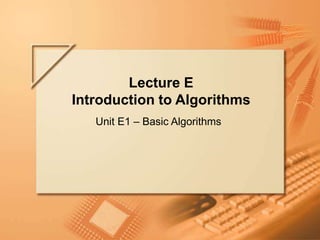This document provides an introduction to algorithms through examples and analysis of running time. It demonstrates algorithms for computing the greatest common divisor and square roots. The greatest common divisor algorithm (Euclid's algorithm) is analyzed for correctness through loop invariants and termination. The square root algorithm uses a binary search approach. Analysis of algorithm running times focuses on counting basic operations and establishing asymptotic behavior using Big-O notation.





















![Slide 22 of 53.
Lesson E – Introduction to Algorithms
Testing operation times on your system
import java.util.*;
public class PerformanceEvaluation {
public static void main(String[] args) {
int i=0; double d = 1.618;
SimpleObject o = new SimpleObject();
final int numLoops = 1000000;
long startTime = System.currentTimeMillis();;
for (i=0 ; i<numLoops ; i++){
// put here a command to be timed
}
long endTime = System.currentTimeMillis();
long duration = endTime - startTime;
double iterationTime = (double)duration / numLoops;
System.out.println("duration: "+duration);
System.out.println("sec/iter: "+iterationTime);
}}
class SimpleObject {
private int x=0;
public void m() { x++; }
}](https://image.slidesharecdn.com/e-230909221220-313e5506/85/e-ppt-22-320.jpg)

























![Slide 48 of 53.
Lesson E – Introduction to Algorithms
Reverse
public class Reverse {
static InputRequestor in = new InputRequestor():
public static void main(String[] args) {
printReverse();
}
public static void printReverse() {
int j = in.requestInt(“Enter another Number”+
” (0 for end of list):”);
if (j!=0){
printReverse();
System.out.println(j);
}
}
}](https://image.slidesharecdn.com/e-230909221220-313e5506/85/e-ppt-48-320.jpg)

![Slide 50 of 53.
Lesson E – Introduction to Algorithms
Fibonaci Numbers
public class Fibonaci {
public static void main(String[] args) {
for(int j = 1 ; j<20 ; j++)
System.out.println(fib(j));
}
public static int fib (int n) {
if (n <= 1) return 1;
return fib(n-1) + fib(n-2);
}
}](https://image.slidesharecdn.com/e-230909221220-313e5506/85/e-ppt-50-320.jpg)
![Slide 51 of 53.
Lesson E – Introduction to Algorithms
TurtleFractal
public class TurtleFractal {
static Turtle turtle = new Turtle();
public static void main(String[] args) {
turtle.tailDown();
drawFractal(500,4);
}
public static void drawFractal(int length, int level){
if (level==0)
turtle.moveForward(length);
else {
drawFractal(length/3, level-1) ;
turtle.turnLeft(60);
drawFractal(length/3, level-1) ;
turtle.turnRight(120);
drawFractal(length/3, level-1) ;
turtle.turnLeft(60);
drawFractal(length/3, level-1) ;
}
}}](https://image.slidesharecdn.com/e-230909221220-313e5506/85/e-ppt-51-320.jpg)

